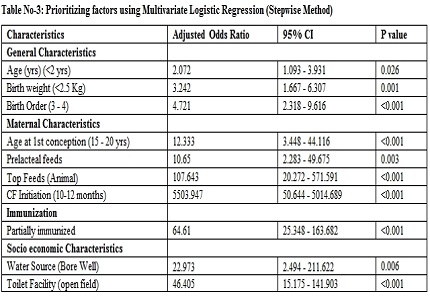Spotlighting risk factors for severe acute malnutrition under 5 years: a case control study
Abstract
Objective: Malnutrition remains one of the most common causes of morbidity and mortality among children throughout the world. W.H.O. has defined Severe and Moderate acute Malnutrition (SAM, MAM) as per specific criteria and there are specific guidelines for better inpatient management of SAM children. Unfortunately, there is not much literature on modifiable risk factors which not only govern the causation but have large impact on prognosis. This study is an attempt to understand and prioritize modifiable risk factors in SAM.
Methods: This is a prospective observational case control study with 200 subjects conducted at a tertiary care hospital after taking written informed consent. A total of 100 cases were enrolled who were children between 6months to 59 months with severe acute malnutrition (diagnosed as per WHO criteria). The 100 controls chosen were age matched children with weight for height >-2SD admitted for other causes. Data regarding birth, maternal education, feeding practices, socio-demographic parameters, immunization, past illnesses and detailed anthropometric measurements were compared by statistical analysis using SPSS package (version 17.0).
Result: A total of 100 cases and 100 controls were enrolled. Out of which 65% cases were below 2 years and 59% of controls were between 2-5years. The study showed that following variables had independent association with severe acute malnutrition: age <2years, low birth weight, birth order >3, younger age of mother at conception, prelacteal feeds, top feeds, delayed initiation of complementary feeds, and partial immunization.
Conclusion: The present study helps to identify significant risk factors associated with severe acute malnutrition which can be of help in deciding preventive measures, management and policy making in future.
Downloads
References
2. Bhutta ZA, Das JK, Rizvi A, Gaffey MF, Walker N, Horton S, Webb P, Lartey A, Black RE; Lancet Nutrition Interventions Review Group; Maternal and Child Nutrition Study Group. Evidence-based interventions for improvement of maternal and child nutrition: what can be done and at what cost? Lancet. 2013 Aug3;382(9890):452-77. doi: 10.1016/S0140-6736(13)60996-4. Epub 2013 Jun 6.
3. Kurup PJ, Khandekar R. Low birth weight as a determinant of protein energy malnutrition in "0-5 years" Omani children of South Batinah region, Oman. Saudi Med J. 2004 Aug;25(8):1091-6.
4. Sufiyan MB, Bashir SS, Umar AA. Effect of maternal literacy on nutritional status of children under 5 years of age in the Babban-Dodo community Zaria city, Northwest Nigeria. Ann Nigerian Med 2012; 6(2):61-64.
5. Appoh L.Y. and Krekling S. Maternal nutritional knowledge and child nutritional status in the Volta Region of Ghana Maternal & child nutrition, 1: 100–110. doi:10.1111/j.1740-8709.2005.00016.
6. Rayhan MI, Khan MSH. Factors causing malnutrition among under five children in Bangladesh. Pak J Nutr. 2006; 5(6):558–562. [PubMed]
7. Amsalu S, Tigabu Z. Risk factors for severe acute malnutrition in children under the age of five: a case control study. Ethiopian Journal of Developmental Health. 2008; 22 (1):21-25. [PubMed]
8. Ghosh S, Shah D. Nutritional problems in urban slum children. Indian Pediatr. 2004 Jul;41(7):682-96. [PubMed]
9. Wang X, Wang Y, Kang C. Feeding practices in 105 counties of rural China. Child Care Health Dev. 2005 Jul;31(4):417-23. [PubMed]
10. Bloss E, Wainaina F, Bailey RC. Prevalence and predictors of underweight, stunting, and wasting among children aged 5 and under in western Kenya. J Trop Pediatr. 2004 Oct;50(5):260-70.
11. Sajilata G, Singhal RS, Kulkarni PR. Weaning foods: a review of the Indian experience. Food Nutr Bull. 2002 Jun;23(2):208-26. [PubMed]
12. Elizabeth KE. Changing profile of undernutrition and edematous severe acute malnutrition (ESAM). Indian Pediatr. 2012 Oct;49(10):843.
13. Haidar J, Abate G, Kogi-Makau W, Sorensen P. Risk factors for child under-nutrition with a human rights edge in rural villages of North Wollo, Ethiopia. East Afr Med J. 2005 Dec;82(12):625-30. [PubMed]
14. Assis A, et al. Growth faltering in childhood related to diarrhoea: A longitudinal community based study. European Journal of clinical nutrition 2005; 59(11): 1317-1323.



 OAI - Open Archives Initiative
OAI - Open Archives Initiative


